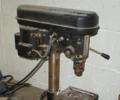![]()
Tutorials:
Power Tools
Must Haves and Wish Lists
(See also: Hand Tools)
Click on any of
the thumbnails below for a more detailed photo
|
|
Although professional knifemakers have some specialized tools worth as much as my house and car put together, I'm going to try to keep this simple and within the reach of the average home hobbyist who has access to a few common hand and power tools. Hacksaw, hammer, coping saw , propane torch, files and some gluing clamps are a good start for hand tools. If you need any of the power tools described below, you could do what I did: check garage sales, flea markets and Ebay. | |
 |
A common belt sander is going to be invaluable for shaping handles, bolsters guards and pomels. For a while I used a simple hand held belt sander mounted upside down in a homemade stand and clamped to my bench. You're going to be doing a lot of sanding and this is a whole lot quicker than doing it by hand. ( Hand sanding however is great exercise guaranteed to build your biceps ). |
|
 |
A At your earliest convenience, upgrade to a bench sander. This one uses 4" x 36" belts. It's a workhorse and is great not just for contour shaping, but also for large flat shaping, such as slabs or scales for full tang knife handles. I start with 120 or 180 grit belts and then save the worn down ones for finer final finishing.
|
|
 |
Jig Saw: Maybe not a "must have" tool but very handy for shaping things like scales to proper profile. If you do this by hand, use a coping saw. Metal cutting blades are available that will cut up to 1/4" thick brass or nickel silver for bolsters or guards. Much faster than using a hacksaw but go lightly, the blades are fragile and brittle. |
|
 |
A rotary tool is probably going to be one of your most often used tools. Dremel is the common name brand but there are others. Used with carbide shaping bits or drills, engraving bits, sanding drums ( shown), fiberglass cutting disks ( capable of cutting even tempered steel ! ) or a wide variety of other accessories. Don't skimp here and buy a cheap one, you'll use this often. Cordless versions are handy but a little bit wimpy. Can also be mounted in a vertical drill stand to make a neat surface router. Click here to see it. |
|
 |
a A drill press should be something to start saving up for now if you're going to get serious in this hobby. Things like carbide drills are very brittle and, if tilted while drilling, will shatter. Great with sanding drums, too. You can duplicate most functions with a hand held power drill, but it's very difficult to provide the same degree of precision. a |
|
 |
A Bench Grinder should be pretty high on your list of most needed tools. Invaluable for removing metal and reshaping hardened steel tangs. Should not however be used on softer metals like brass or nickel silver inasmuch as these metals will load the wheels up and render them pretty useless. a |
|
 |
a A circular buff is a "must have". Can be mounted in anything with a chuck, including a hand drill clamped into a bench stand. Always used for the final polishing of any metal parts after final sanding with a 400 grit wet or dry sandpaper. Used with a very slightly abrasive buffing compound which usually comes in bar form. Warning: harmless as it looks, this is the tool I warned you about in the safety tutorial that unexpectedly grabs knives! a |
|
 |
I love my bandsaw and it's probably one of my most often used tools, but strictly speaking other than vertically splitting a set of scales, there's not a lot that can't be duplicated with other hand tools and smaller power tools. I usually use it to give a final profile slabs that have been epoxied to full tang knives and to give a final profile to block handles. Most bandsaws also have metal cutting blades available | |
Wish List: I'll add to this list as I think of them. Any suggestions?